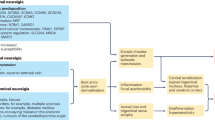Abstract
The protein nerve growth factor (NGF) is a naturally occurring trophic substance for sympathetic neurones1–3 and for at least those primary sensory neurones containing substance P (refs 4–6). Thus retrogradely transported NGF increased substance P and protein content in corresponding dorsal root ganglia6. Moreover, anti-NGF antibodies administered to newborn rats decreased substance P and somatostatin levels in dorsal root ganglia and dorsal spinal cord4,5,7, suggesting an important role for NGF in the postnatal development of peptidergic sensory neurones. These neurones appear to be selectively affected by the neurotoxin capsaicin (8-methyl-N-vanillyl-6-nonenamide)8. Treatment of newborn rats with capsaicin led to degeneration of primary sensory neurones containing substance P, somatostatin, vasoactive intestinal polypeptide and cholecystokinin9–16. The mechanism by which capsaicin evokes its neurotoxic effect is unknown. We report here that in newborn rats concomitant administration of NGF partially antagonized the deleterious effect of capsaicin on substance P-containing neurones in dorsal root ganglia as assessed by morphological and biochemical criteria. We conclude that capsaicin destroys the perikarya of primary sensory peptidergic neurones by interfering with the action of NGF, probably by blocking its retrograde axonal transport.
This is a preview of subscription content, access via your institution
Access options
Subscribe to this journal
Receive 51 print issues and online access
$199.00 per year
only $3.90 per issue
Buy this article
- Purchase on Springer Link
- Instant access to full article PDF
Prices may be subject to local taxes which are calculated during checkout
Similar content being viewed by others
References
Thoenen, H. & Barde, Y. A. Physiol. Rev. 60, 1284–1335 (1980).
Hendry, I. A., Stoeckel, K., Thoenen, H. & Iversen, L. L. Brain Res. 68, 103–121 (1974).
Paravicini, U., Stoeckel, K. & Thoenen, H. Brain Res. 84, 279–291 (1975).
Otten, U., Goedert, M., Mayer, N. & Lembeck, F. Nature 287, 158–159 (1980),
Otten, U., Peck, M., Businger, F., Schlumpf, M. & Lichtensteiger, W. in Monographs in Neural Sciences (Karger, Basel, in the press).
Goedert, M., Stoeckel, K. & Otten, U. Proc. natn. Acad. Sci. U.S.A. 78, 5895–5898 (1981).
Otten, U. Naunyn-Schmiedeberg's Archs Pharmak. Suppl. 319, 74 (1982).
Jancsó, G., Király, E. & Jancsó-Gábor, A. Nature 270, 741–743 (1977).
Kessler, J. A. & Black, I. B. Proc. natn. Acad. Sci. U.S.A. 78, 4644–4647 (1981).
Jessell, T. M., Iversen, L. L. & Cuello, A. C. Brain Res. 152, 183–188 (1978).
Nagy, J. I. et al. Brain Res. 186, 435–444 (1980).
Gamse, R., Holzer, P. & Lembeck, F. Br. J. Pharmac. 68, 207–213 (1980).
Gamse, R., Leeman, S. E., Holzer, P. & Lembeck, F. Naunyn-Schmiedeberg's Archs Pharmak. 317, 140–148 (1981).
Cuello, A. C., Gamse, R., Holzer, P. & Lembeck, F. Naunyn-Schmiedeberg's Archs Pharmak. 315, 185–194 (1981).
Nagy, J. I., Hunt, S. P., Iversen, L. L. & Emson, P. C. Neuroscience 6, 1923–1934 (1981).
Jancsó, G. et al. J. Neurocytol. 10, 963–980 (1981).
Bocchini, V. & Angeletti, P. U. Proc. natn. Acad. Sci U.S.A. 64, 787–794 (1969).
Kornblum, H. I. & Johnson, E. M. Brain Res. 234, 41–51 (1982).
Kessler, J. A. & Black, I. B. Proc. natn. Acad. Sci. U.S.A. 77, 649–652 (1980).
Otten, U. & Lorez, H. P. Neurosci. Lett. (in the press).
Ross, M., Löfstrandh, S., Gorin, P. D., Johnson, E. M. & Schwartz, J. P. J. Neuroscience 1, 1304–1311 (1981).
Mayer, N., Lembeck, F., Goedert, M. & Otten, U. Neurosci. Lett. 29, 47–52 (1982).
Levi, A., Schechter, Y., Neufeld, E. J. & Schlessinger, J. Proc. natn. Acad. Sci. U.S.A. 77, 3469–3473 (1980).
Konigsmark, B. W. in Contemporary Research Methods in Neuroanatomy (eds. Nauta, J. H. & Ebbesson, S. O. E.) 315–340 (Springer, New York, 1970).
Sternberger, L. A. Immunocytochemistry 246 (Prentice-Hall, Englewood Cliffs, New Jersey, 1974).
Redmann, G. Microscopy 33, 102 (1972).
Mroz, E. A., Brownstein, M. J. & Leeman, S. E. in Substance P (eds von Euler, U. S. & Pernow, B.) 147–155 (Raven, New York, 1976).
Author information
Authors and Affiliations
Rights and permissions
About this article
Cite this article
Otten, U., Lorez, H. & Businger, F. Nerve growth factor antagonizes the neurotoxic action of capsaicin on primary sensory neurones. Nature 301, 515–517 (1983). https://doi.org/10.1038/301515a0
Received:
Accepted:
Issue Date:
DOI: https://doi.org/10.1038/301515a0
This article is cited by
-
The protective effect of nerve growth factor in nerve tissue cultures exposed to diphtheria toxin
Neuroscience and Behavioral Physiology (1999)
-
Desensitization of capsaicin-evoked neuropeptide release — Influence of Ca2+ and temperature
Naunyn-Schmiedeberg's Archives of Pharmacology (1990)
-
Capsaicin-induced inhibition of axoplasmic transport is prevented by nerve growth factor
Cell and Tissue Research (1985)
-
Recent advances in the use of selective neuron-destroying agents for neurobiological research
Experientia (1984)
Comments
By submitting a comment you agree to abide by our Terms and Community Guidelines. If you find something abusive or that does not comply with our terms or guidelines please flag it as inappropriate.



